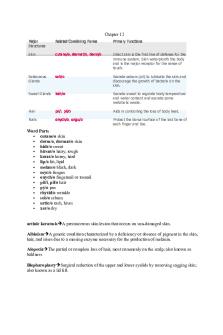Chapter 12 Worksheet, Rubenstein & Alcock PDF

| Title | Chapter 12 Worksheet, Rubenstein & Alcock |
|---|---|
| Course | Animal Behavior |
| Institution | Creighton University |
| Pages | 2 |
| File Size | 55.3 KB |
| File Type | |
| Total Downloads | 46 |
| Total Views | 146 |
Summary
Chapter 12 worksheet questions and answers for BIO 371 with Dr. Burk....
Description
BIO/EVS 371. Animal Behavior. Fall 2020.
Name: Kathleen Bracken
Worksheet for Chapter 12 of Rubenstein & Alcock. (15 points possible.) Answers are worth one point each unless otherwise indicated. 1.)
(3 points) What are the three defining attributes of "eusociality"? The three defining attributes of “eusociality” are (1) having overlapping generations, (2) cooperative care of young, and (3) many individuals in a group are temporarily or permanently sterile.
2.)
How is "altruism" defined in behavioral biology? “Altruism” in biology is defined as a behavior that benefits others to the detriment of the one performing the behavior. An example of altruism would be the self-sacrificing behavior of worker ants that stay outside the nest to seal off the entrance in the evening, despite the fact this means they won’t survive the night.
3.)
What is the "Coefficient of Relatedness" (r)? The “Coefficient of Relatedness” (r) is an estimate of the degree of genetic relatedness between two individuals. It refers to the probability that the same allele is present in two individuals who both inherited it from a recent common ancestor.
4.)
In a typical diploid species such as humans, what is the value of r for full siblings? In a typical diploid species, the value of r for full siblings is ½, or 0.5
5.)
(2 points) Explain the difference between "direct fitness" and "indirect fitness". The difference between “direct fitness” and “indirect fitness” is that direct fitness refers to the fitness gained through personal reproduction, while “indirect fitness” refers to fitness gained by an altruistic individual that help non-descendant kin survive and reproduce.
6.)
What is the formula for "Hamilton's Rule"? The formula for “Hamilton’s Rule” is that a gene for altruism will only spread if rB > C. r = the genetic relatedness between two individuals B = the benefit (reproductive units) gained by the recipient of the altruistic act C = the cost (reproductive units lost) to the individual performing the altruistic act
2
7.)
What is "haplodiploidy"? “Haplodiploidy” is a sex determination system in which males are haploid and females are diploid.
8.) and
In a haplodiploid species, what is the value of r for two sisters with the same mother father? In a haplodiploid species, the value of r for the two sisters with the same mother and father is 0.75.
9.)
In a haplodiploid species, what is the value of r between a queen and her daughter? In a haplodiploid species, the value of r between a queen and her daughter is 0.5.
10.)
Give one example of eusocial species that are diploid. One example of a diploid, eusocial species is termites.
11.)
In the context of eusocial insects, what is "the Monogamy Hypothesis"? The “Monogamy Hypothesis” states that lifetime monogamy ensures that siblings are highly related, making obligately sterile workers and ultimately eusociality more likely to evolve.
12.)
In the context of eusocial insects, what is "worker policing"? “Worker policing” is when workers prevent other workers from laying eggs, or they destroy or consume eggs laid by other workers....
Similar Free PDFs

Alcock case summary
- 1 Pages

CO2409-12 Lab Worksheet
- 4 Pages

Diversity Worksheet 12
- 2 Pages

Grok worksheet 12
- 13 Pages

Chapter 12
- 14 Pages

Chapter 12
- 20 Pages

Chapter 12
- 18 Pages

Chapter 12
- 2 Pages

Chapter 12
- 16 Pages

Chapter 12
- 10 Pages

Chapter 12
- 46 Pages
Popular Institutions
- Tinajero National High School - Annex
- Politeknik Caltex Riau
- Yokohama City University
- SGT University
- University of Al-Qadisiyah
- Divine Word College of Vigan
- Techniek College Rotterdam
- Universidade de Santiago
- Universiti Teknologi MARA Cawangan Johor Kampus Pasir Gudang
- Poltekkes Kemenkes Yogyakarta
- Baguio City National High School
- Colegio san marcos
- preparatoria uno
- Centro de Bachillerato Tecnológico Industrial y de Servicios No. 107
- Dalian Maritime University
- Quang Trung Secondary School
- Colegio Tecnológico en Informática
- Corporación Regional de Educación Superior
- Grupo CEDVA
- Dar Al Uloom University
- Centro de Estudios Preuniversitarios de la Universidad Nacional de Ingeniería
- 上智大学
- Aakash International School, Nuna Majara
- San Felipe Neri Catholic School
- Kang Chiao International School - New Taipei City
- Misamis Occidental National High School
- Institución Educativa Escuela Normal Juan Ladrilleros
- Kolehiyo ng Pantukan
- Batanes State College
- Instituto Continental
- Sekolah Menengah Kejuruan Kesehatan Kaltara (Tarakan)
- Colegio de La Inmaculada Concepcion - Cebu




